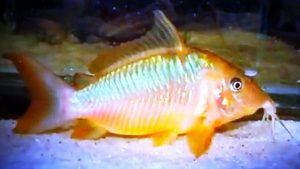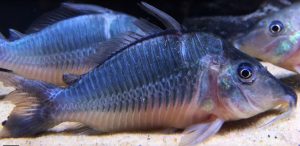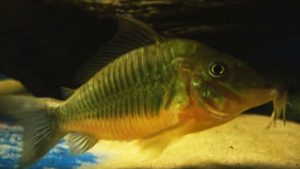The Hognose Brochus (Brochus Multiradiatus) also known to tropical fish keeping enthusiasts as the Armor Moth or Long Finned Brochis is native to the northwestern Amazon Basin in Ecuador, Peru, and Bolivia. They are locally collected from tributaries of the Río Lagartococha near the town of Garza-Cocha, in the upper Río Napo system, of the Napo Province, Ecuador.
The Corydoradinae sub-family contains the Aspidoras, Brochis, and Corydoras genra which are all closely related and nearly identical in their behaviour and housing requirements. Brochis Multiradiatus is less common than Brochis splendens in the aquarium trade.
Hognose Brochus are a large, peaceful, schooling species that prefer living in densely vegetated, still, sluggish backwaters, oxbows, marginal lakes, and slow moving streams where they forage along the bottom for small aquatic invertebrates, worms, insect larvae, etc.
The rised intestine in Hognose Brochus has evolved to facilitate the intake of atmospheric oxygen which allows them to survive in oxygen depleted environments. Like many Corydoras, you will occasionally see them rising to the surface to take in gulps of air for no apparent reason.
In their natural habitat, Brochus Multiradiatus grow to almost 4 inches in length, and slightly less in an aquarium environment. They are regarded as great bottom cleaners by most tropical fish keeping enthusiasts.
Hognose Brochus have a long, elongated, hog like snout and between 15 to 18 soft dorsal fin rays (usually 17). The dorsal, pectoral and adipose fins are each preceded by a spine which is actually a hardened, modified ray.
When threatened or attacked, the dorsal and pectoral fin spines can be locked into position and are capable of causing a nasty “sting”. The axillary glands at the base of each spine secrete a mildly venomous or toxic substance that can cause some serious pain if handled improperly.
Both sexes are a beautiful striking iridescent gold to emerald green/brown color above, with a light creme to yellow/pinkish white underbelly in appearance. Females are slightly larger, higher bodied, and noticeably rounder than males.
Hognose Brochus should be housed in a 55 gallon tank with a sandy or very fine gravel substrate, aquascaped with a few river rocks, some driftwood arranged as hiding places, and some Indian Almond leaves
on the bottom to replicate their natural environment. The aquarium can be planted but because of their tendency to uproot aquatic plants, potted plants are recommended. Some floating plants
can also be added to diffuse overhead lighting.
Hognose Brochus make perfect candidates for larger South American community tanks with medium size South or Central American Cichlids that are not so large as to make a meal of them. When housed in a shoreline riverine bio tope setting, at least 10 or more specimens should be kept together in a small shoal.
Although no successful spawning of Brochus Multiradiatus has been documented, they are known to collect their eggs in a basket made by the female’s pelvic fins and individually deposit them on rocks, plants, driftwood, or on the aquarium glass. The females are prolific egg layers that can produce well over 1,000 eggs per spawn.
In their natural environment, Hognose Brochus root around the bottom among the leaves with their snouts to find insect larvae, small crustaceans, worms, etc. In an aquarium environment they will eat anything off the bottom of your tank but should also be fed a quality omnivore sinking pellet, shrimp pellets, and live, frozen, or freeze dried bloodworms
, tubifex, chopped earthworms, brine shrimp, etc.
When you can find them available for purchase, they are usually between 1.5″ to 2.5″ in length.
Minimum Tank Size: 55 gallons
Care Level: Easy
Temperament: Peaceful
Water Conditions: 70-78° F, KH 2-12, pH 6.0-7.5
Max. Size: 4”
Color Form: Green, Gold, White
Diet: Omnivore
Compatibility: Larger, peaceful community tanks
Origin: Bolivia, Ecuador, Peru
Family: Callichthyidae, Sub-Family Corydoradinae
Lifespan: 8 – 10 Years or more
Aquarist Experience Lever: Intermediate





